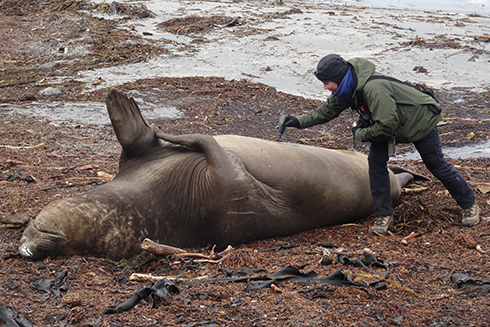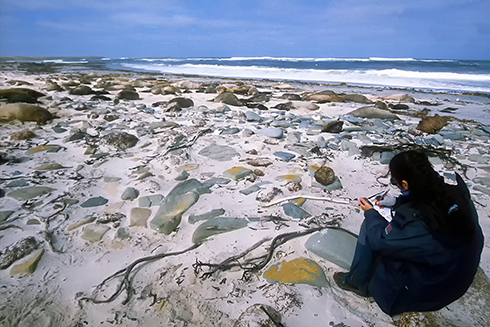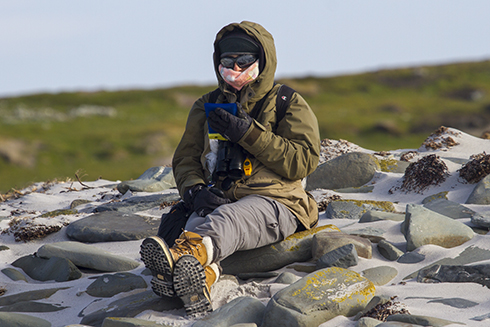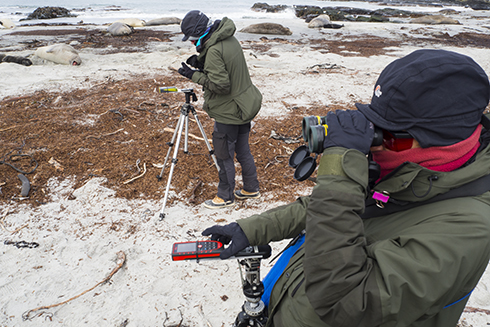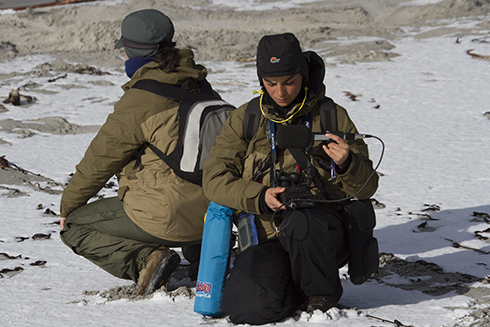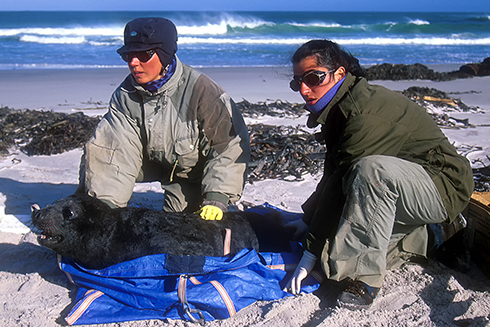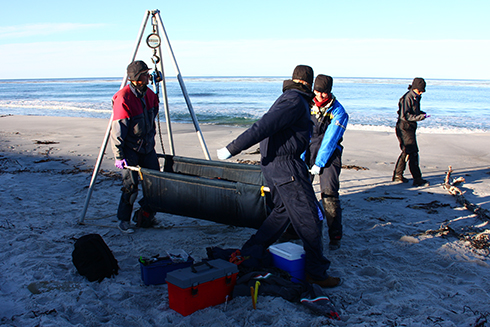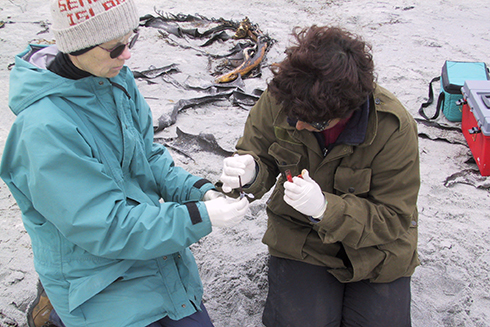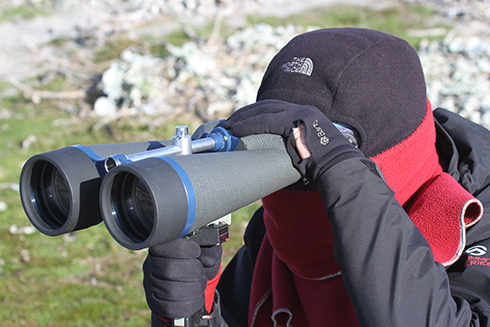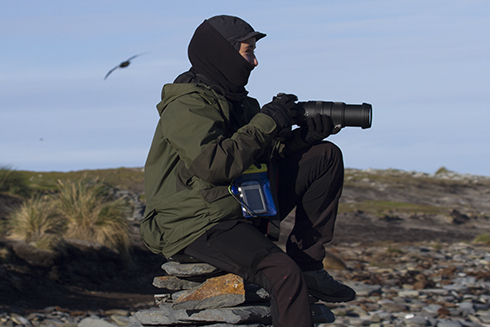What the helpers do in the field
Introduction
Our field helpers collborate to the collection of data for all our research project. Their main job is to collect baselines data for our long term study of elephant seals, but they can be involved in many other activities, from orcas photoidentification, to skua counts, to environmental monitoring at large.
The specific jobs and duties changes from one season to the other, depending on the specific research projects, the term of the research licenses, and the size of the research team. It is of paramount importance that field helpers are ready, and happy, to cope with a flexible, and at times very demanding, work schedule. Working with us at Sea Lion Island is definitely not vacation time.
Weather conditions

Going to the field in a snowy day
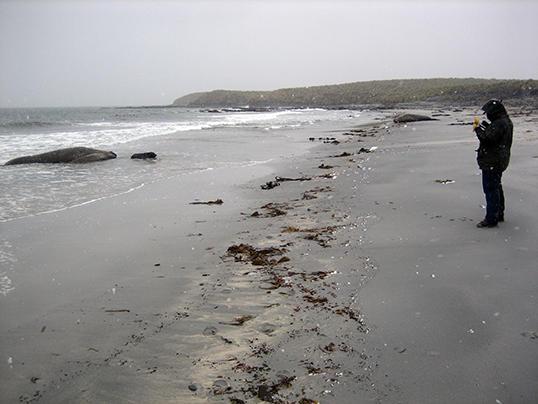
Observing an elephant seal departure under the snow
Equipment
Field helper carry a lot of equipment. Each helper always carries binoculars to observe, palmtop computer to record data, GPS receiver to map seals, GPS logger to record the operator track, digital camera with long zoom lens to get killer whale pictures, dye marking stuff, etc. On top of this each helper usually carries extra clothes, spare batteries, food, water, etc. It is a lot of stuff, and all together is defintely heavy !
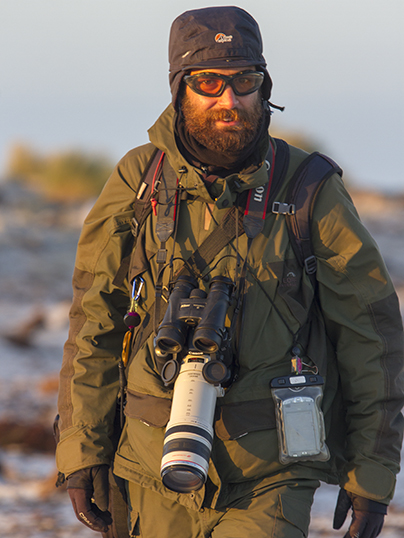
A fully equipped field helper; please note the big zoom lens and digital camera, used to get the killer whale photos that permit individual photo-identification
Data collection
Data collection is fully digital. We use palmtop computer that are operated using a stylus. The data collection system is based on a large set of relational databases.The actual data collection is carried out through forms that make data inputting easiear, thorugh pop up menus and list pf choices. Notwithstanding this, the data collection is not easy, because a lot of different bits of information need to be collected for the different research projects. Moreover, the palmtop computers are often operated in bad weather conditions, with poor lighting, and using heavy gloves. Field helpers should be ready to invest a significant amount of time to learn the theory and practice of our data collection system, and to improve their data collection skills while in the field.
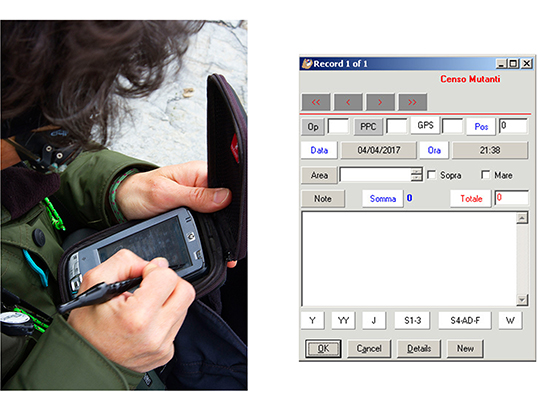
Collecting data on palmtop computer
Elephant seals
Dye marking
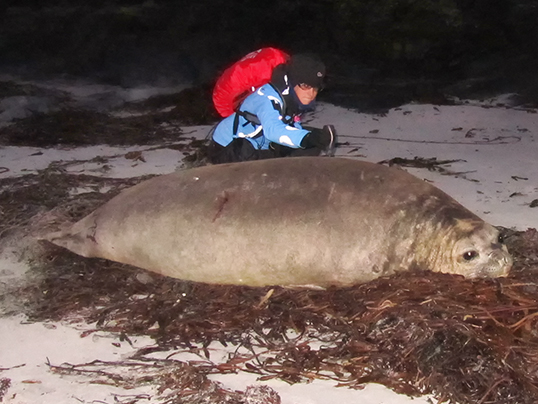
First dye mark of a new helper, in the early morming, on a recently arrived breeding female. Please note that: 1) we dye mark seals only during the breeding season (there is no dye marking during the moult); 2) dye marking is a very important part of the helper field work, and requires to work frequently at very close distance from the seals; 3) helpers are not allowed to mark seals by tagging (due to limitations of the research licence); the only exception is tagging of weaned pups during handling operations, in which helpers can tag the pups because they are always under strict supervision of a PI or field technician.
Census and counts
The elephant seal daily census is one of the most important and most demanding task of field helpers. Elephant seals can be packed in large harems or moulting groups, can rest on a difficult terrain, and can occupay areas inundated by the high tide. During the census field helpers need not only to count the seals, but also to identify them. Although we dye mark intensively during the breeding season, we need anyway to read tags, and that can be difficult (see below).

An harem in which all seals are dye marked, but just a few marks (red arrows) can be seen at first sight
The daily census can be a particularly demanding task in specific situations, in particular for the seal identification and tag reading. The following is a sample of situations in which the census carried out by field helpers can be difficult.

Sea Lion Island is a very windy place, and seals can be literally covered by sand, that makes mark reading very difficult
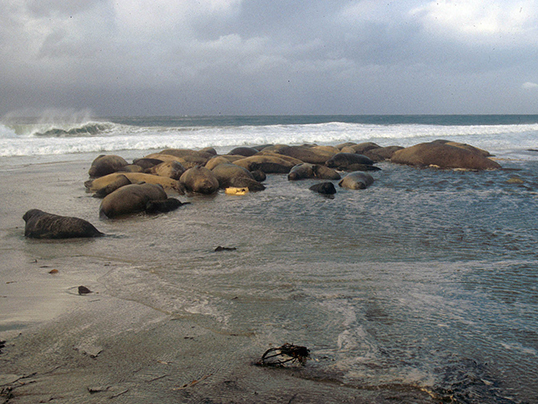
An harem flooded suring the high tide: although we try to carry out the census at low tide field helpers should be ready to do their best to count and identify seals even in this difficult condition
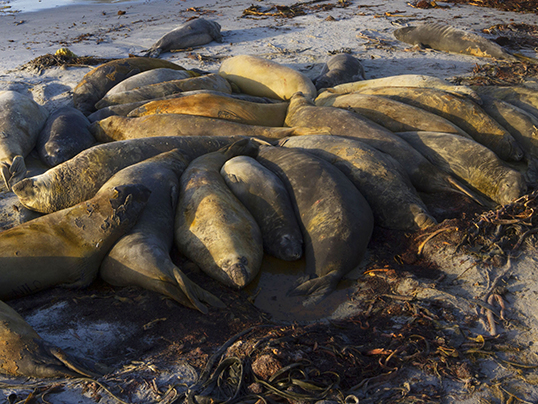
Moulting elephant seals can be packed one on top of the other: in this situation reading tags (moulters are not dye marked) can be a challenging task

Moulters like to rest into rotten and wet kelp: in this situation even the simple task of getting close enough to them to read tags can be a demanding, and very smelly !, task
Mapping using GPS receivers
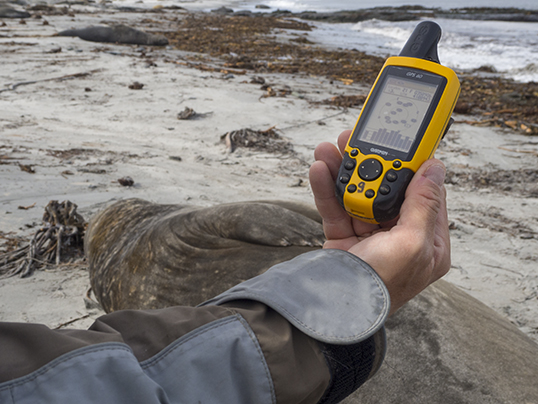
Taking the position of a male seal using a Garmin GPS
A main goal of our research is to collect data that is geo-referenced, that is to say it is accurately located in space. To achieve this goal we use GPS receivers, and almost all bit of data that we collect is linked to a GPS position.Although the procedure is very simple, our volunteers take thousands and thousands of positions every season, and, therefore, they spend a significant amount of time just pushing a GPS button.
Tag reading
Reading tags is probably the most important job of our field helpers. The long term tagging and re-sighting program is possibly the best part of our elephant seal study.

A field helper trying to read the tag of a breeding female
Tag reading can be difficult because of the variable quality of the tag print. You should rember that many of our tags have been in place for 10 or 15 years, on seals that spend the most of their time at sea !
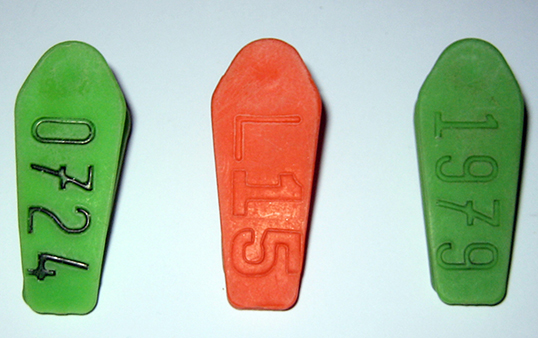
Some tags are pretty difficult to read
Observation of behaviour

Observing an elephant seal harem from a vantage point
The study of elephant seal behaviour is the main goal of our research. Therefore, our field helpers spend a very large amount of time observing the seals. This is a very demanding job, because it is carried out with any weather, in the cold, under the rain, exposed to heavy wind. Moreover, elephant seals have burst of activity and long periods of resting.Therefore, our field helpers spend a significant amount of time watching seals that are just resting or sleeping. Maintaining concentration while observing seals that do nothing is not easy, but our helpers should well keep in mind that also this data is very important from a scientific point of view.

Observing in the cold
Please keep in mind that is strictly forbidden to sleep, lissen to music, play with the smartphone, read or write while doing observations of behaviour, to avoid biases in data collection, missing data, and recording mistakes.
Measuring size and morphology

A field helper is trained in the use of a rangefinder to estimate seal size
An important part of our research regards the effect of the structural phenotype (age, size, morphology) on behaviour, and, in particular, on the mating and breeding strategy. For example, body length can affect male mating success, and body weight can affect maternal investment. Measuring size and morphology in elephant seals is not easy, because they are big ! Therefore, we use a lot of different indirect non-invasive methods to measure seals (see link). Field helpers are often required to help collecting size data using those methods. In particular, they collect data on female size using a new method that we devised that is based in application of simple trigonometry to distances and angles measured using a range finder.
Weighing of pups
Field helpers collaborate to the weighing and measuring of weaned pups. They are big and heavy !

A very big weaned pup (the person the photo is about 1.65 m tall)
Although the population average weight at weaning is 137 kg, weanlings can weigh more than 200 kg, and that's without the weight of the weighing bag, that is itself about 10 kg. Moreover, weanlings are captured and restrained by hand, and the operation should be carried out as fast as possible to reduce subject stress to the absolute minimum. All together, it is very important that field helpers are in good phisical condition, have no back problems at all, are very focused and motivated, and are ready to put a lot of effort in weighing operations.

Capture of a weaned pup

Transportation of a weaned pup to the weighing tripod

Weighing of a weaned pup by lifting on a tripod
Measurement of weanling body length is a demanding task, because the team need to keep the weaned pup in place, and straight, to obtain a good measurement, and that is not easy because pups are definitely not happy to be locked down on their back.

Measuring the standard body lenght of a weaned pup
Killer whales
Our research project on killer whales is base on four main components: coast surveys, observations from vantage points, photo-identification, and videorecording fromm drones. Field helpers collaborate to the first three jobs. Please note that we are not allowing our field helpers to fly our drones. Our drone research licence strictly required drones to be operated by people with good experience of both drone flying over wildlife, and the peculiarities of Sea Lion Island environment and wildife, to reduce evironmental risks and impact.
Coast surveys
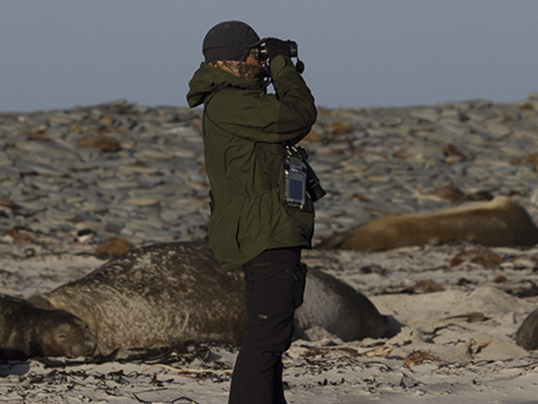
Scanning the sea at 5 minutes interval during a coast survey
The most demanding component of our killer whale project are coastal surveys. A costal survey mean simply to walk along the coastline of Sea Lion Island regularly scanning with binoculars the visible sea surface. This is a lot of walking, often on difficult terrain, and requires a good deal of concentration, to be able to spot killer whales as soon as they became visible.
Observation from vantage points
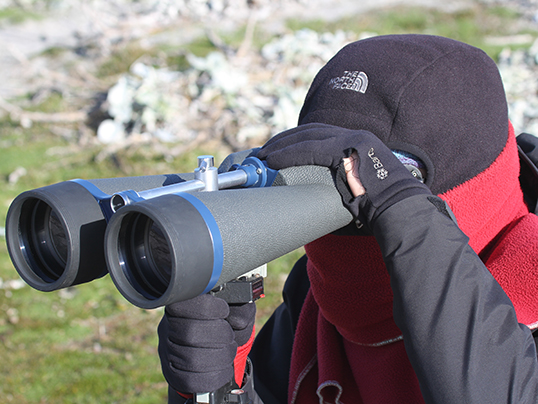
Observing killer whales from a vantage point
Apart from coastal surveys, we do observations from vantage points, that are high points from which is possible to have a wide angle of view on the sea. Observations from vantage points are difficult because it is to get bored and fall asleep when killer whales are not on sight. Obviously, to obtain standardized data we need to be sure that observers are effectively observing the sea even when killer whales are not on sight.
Killer whale pictures and videos
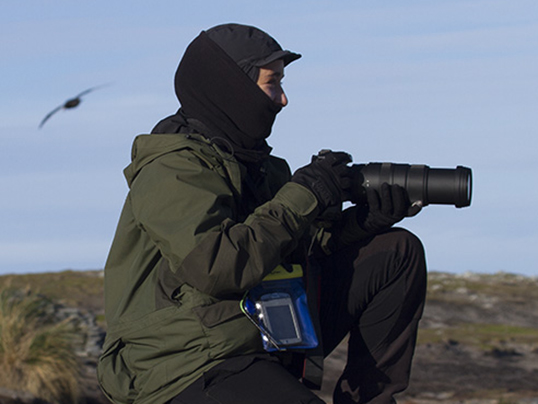
Ready to get killer whale photos (please not big and heavy camera)
Field helper are striclty required to learn well how to use our digital cameras (see Equipment section above), always carry one of those cameras while in the field (and they are heavy !), and use cameras to get killer whale photos and videos. Killer whale photos are a big priority of the field work, because they permit us to identify the individuals with a good degree of certainty. Field helpers are required to spend a good amount of time studying our killer whale catalogue before coming to Sea Lion Island, to memorize the individual features of each killer whale. Notwithstanding this, and the training that we provide in the field, most helpers at first have big problems to recognize the different individuals, and, therefore, photos are the only way to get safe identification. Moreover, often killer whales that cannot be recognized by binoculars can be identified in enlarged photos. After getting enough photos to permit photoidentification, helpers are required to take videos, if possible, to document killer whale behaviour.
The weanling pool

Killer whales getting into the weanling pool
At Sea Lion Island, we have a peculiar place, called "the weanling pool", were elephant seal weaned pups aggregate, sometimes in very big numbers. Some of our killer whales learned out to get into the pool, and caputer the weanlings there. It is a very interesting situation, and, therefore, an important part of the field helpers field is to carry out observation at the weanling poool.
Timing of the killer whale field work
Killer whales are more frequently observed in the early morning and late evening. This means that helpers of the morning shift may be required to be in the field by 03:30 AM in the morning, and that helpers of the eveing shift ma end their effective field work at 09:30 PM, or even a bit later if killer whales are on sight and there is enough light to carry on observations.
Skuas
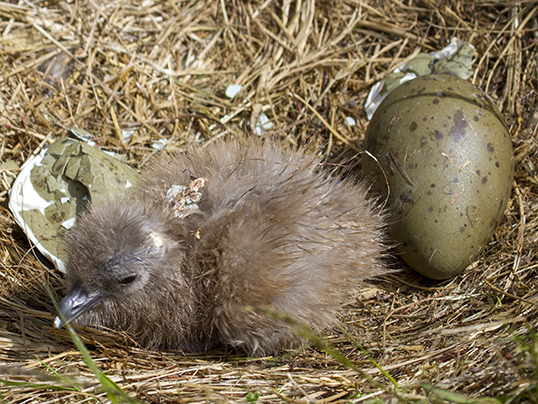
Checking a skua nest
The main componrnt of our skua project is the monitoring of the nesting, breeding and fledging success. This is based on weekly censuses, carried out from early November to mid March, in which we locate nests, check nests for eggs and chicks, locate chicks, and record various kinds of information about the nest and surrounding habitat, adults, eggs, chicks, and their behaviour. We have two skua nesting areas, one close to the settlement and one at the west end of the island, and each area is usually assigned to one field helper. Please note that, although we try to keep disturbance to the minimum, skuas can be very aggressive when people approach their nest.
Environmental monitoring
Depending on the season, field helpers are required to carry out simple tasks related to our Sea Lion Island environmental monitoring program. This can include counts of southern sea lions, recording cetacean observations and strandings, collecting opportunistic records about the different bir species, counting penguing, map topographic features and vegetation using GPS receivers. The specific tasks of each season are usually established with a rather short advance because the committment that put into this project is proportional to the team size, and the time that is left after taking care of our main projects.
Collecting and processing sample
Depending on the specific research project of each season, field helpers may collaborate to the collection and processing of biological samples. We can collect various kind of samples, including: 1) skin, for genetic studies; 2) blood, for hormone studies; 3) urine and scats, for pathogen studies; 4) fur and vibrissae, for stable isotope analysis (diet); 5) buccal, nasal and rectal swabs for pathogen studies; 6) external and internal parasites. Processing is limited to simple operations, that are needed to better preserve/use the sample, like separating blood serum. No complex lab work is required, and basic training about pipetting, centrifuge spinning, etc. will be provided if needed.
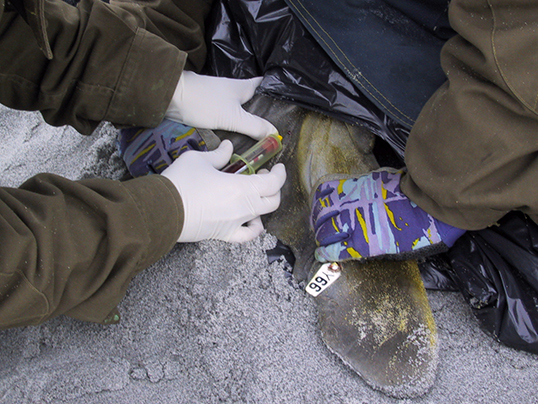
Taking a blood sample from the rear flipper of a weaned pup during a weighing operation
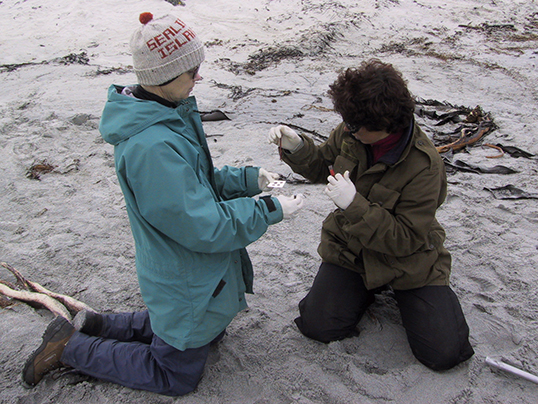
Spotting blood on filter paper for hormone studies
We would like to emphasize that: 1) field helpers may not be required at all to collect/process samples, because many of our projects do not require biological samples; 2) field helpers will be advised as soon as possible if collection and processing of samples will be required, but we cannot take a committment to advise helpers on this before their recruitment; 3) if collection and processing of samples will be required, field helpers will receive a specific training; 4) although we have a colletion/sampling safety protoco, and we strive to respect it as much as possible, the collection is carried out in the field and the processing is carried in the very limited lab facilities that we have at Sea Lion Island.
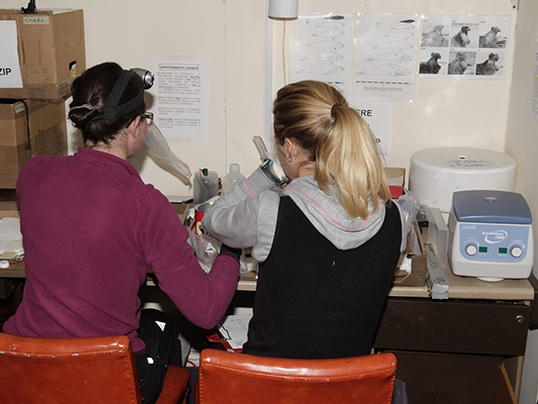
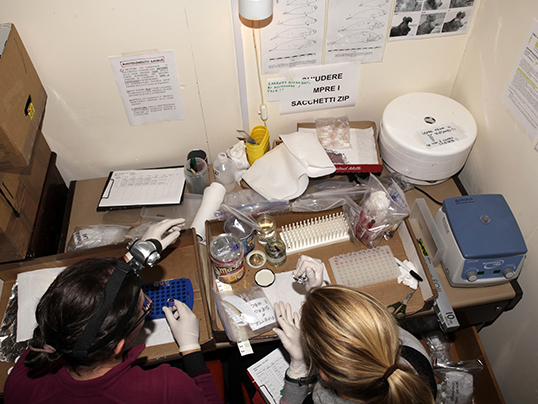
Processing of blood samples for serum separation
Office work
Field helpers may be required to carry out simple office work realted to our different research projects. For example, they can be asked to identify killer whales in photos, to count penguins in drone pictures, and to take skull photos that are used to build 3D models of them. The amount of office work changes depensing on the season, and on each specific helper. For example, we can use office work as non-field work time to helpers that are are not able to carry the field work. This can be bacause temporarily injured or particularly tired. In any case, office work is a minor committment of our helpers, that are required to spend in the field the most of their work time.


